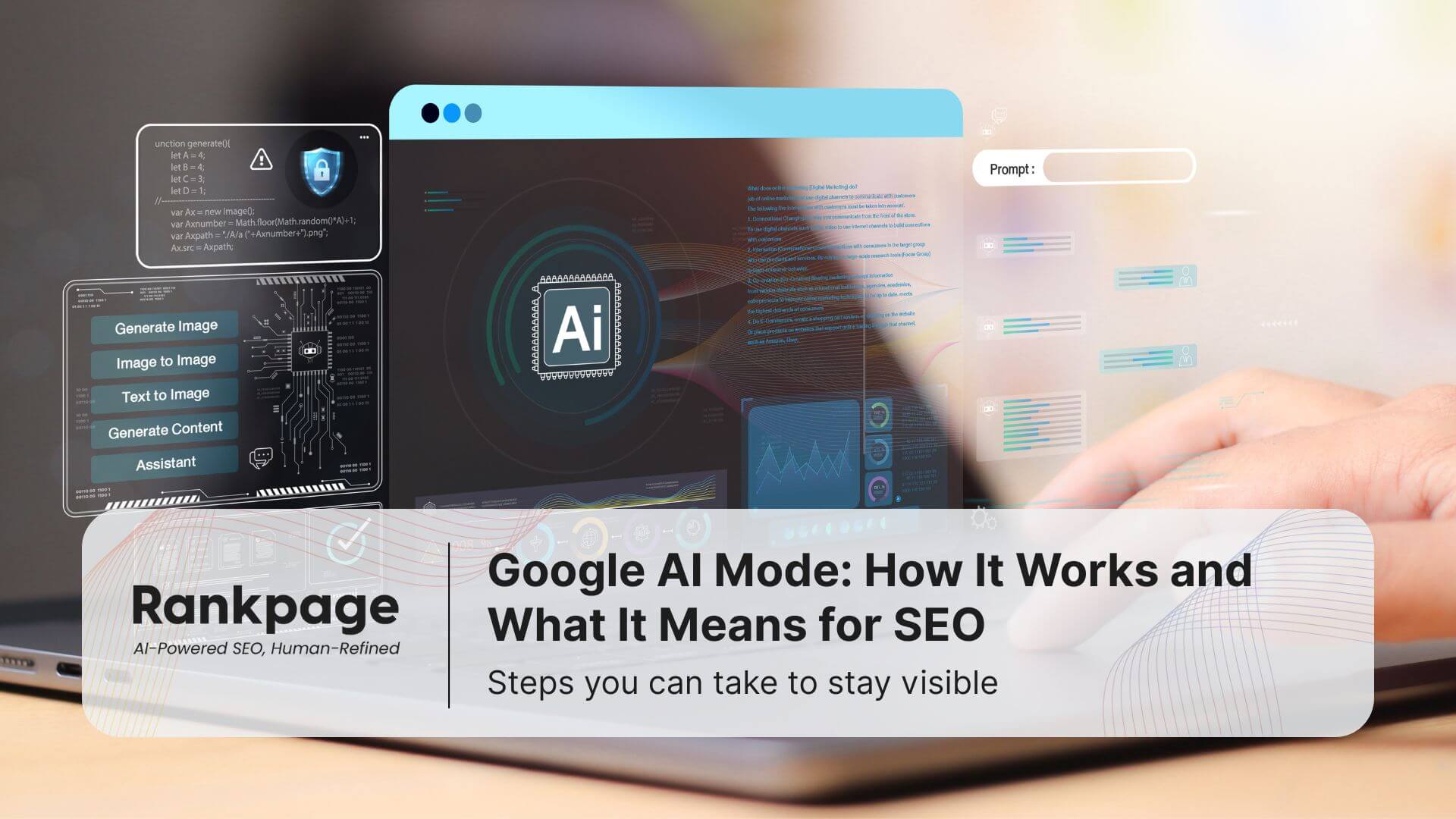Key Takeaways
- Google AI Mode delivers conversational answers that break queries into sub-questions, pulling from multiple sources instead of only showing ranked blue links.
- Content discovery now depends on passage-level relevance, where even a single paragraph or FAQ section can surface inside AI summaries.
- SEO shifts from ranking to citations — visibility relies on being referenced in summaries, carousels, and “Explore more” links.
- Tracking AI Mode visibility requires new KPIs, such as Share-of-Answer, Cited-Source Coverage, and sentiment/accuracy checks of AI summaries.
- Businesses must optimise structure and clarity, using headings, schema, FAQs, and expert-backed writing to align with AI’s query fan-out and retrieval process.
Google AI Mode is a new way to search that uses generative AI to give full answers, not just links. It reshapes SEO by prioritising citations, context, and passage-level relevance.
If that sounds like it changes SEO, you’re correct. For anyone publishing content, AI Mode means visibility depends less on rankings and more on whether Google cites you inside its conversational answers.
But how do you get cited and would it affect traditional search?
Today, the leading SEO agency in Malaysia, will explain how Google AI Mode works and more! Why it matters for SEO, and the exact steps you can take to stay visible. Let’s get to it.
Table of Contents
Comparison Table: Google AI Mode vs AI Overviews vs Classic Search
AI Overviews and AI Mode are often mentioned in the same breath, but they are not the same thing.
Feature | Google AI Mode (2025) | AI Overviews (2023–2024) | Classic Search (Blue Links) |
User Inputs | Text, voice, image (multimodal) | Text-based queries only | Text-based queries only |
Response Style | Full conversational answer + follow-ups | Short AI-generated summary | List of ranked website links |
Content Source | Passages, stats, images across web | Snippets + structured content | Full web pages ranked by signals |
SEO Impact | Citation-based visibility (not positions) | Higher snippet reliance | CTR depends on ranking position |
Measurement | No direct reporting (manual tracking needed) | Minimal (GSC impressions only) | Full GSC/GA data available |
Ads Integration | Rolling out in 2025 | Not integrated | Mature ad ecosystem |
Availability | Most countries / territories (English | 200+ countries / 40+ languages” | Global |
AI Overviews
- Appear on top of standard SERPs for certain queries.
- Provide a short, generated summary with a few citations.
- Designed for quick answers without leaving the classic search page.
Google AI Mode
- Works as a dedicated tab or button for deeper, multi-turn answers.
- Handles multimodal inputs: text, voice, and images.
- Creates longer, stitched responses and allows follow-up “chips” to continue the conversation.
Classic Search
- Still the default experience for most users today.
- Ranking positions matter here, but in AI Mode, citations replace rankings as the visibility metric.
“AI Overviews are like a “preview layer” on top of normal results, while AI Mode is a full conversational search environment.”
But it’s to remember that optimising for one doesn’t always guarantee visibility in the other.
What Is Google AI Mode?
Google AI Mode is a search feature that uses generative AI to deliver conversational answers instead of ranked links. It breaks down queries, pulls passages from multiple sites, and presents a stitched summary.
Unlike AI Overviews, which appear on certain queries, AI Mode is an opt-in tab or button where users get deeper, multi-turn responses.
It works with text, voice, and even images, making it more flexible than classic search.
For site owners, this means your content may be cited in summaries even if your full page isn’t ranking in the top 10.
How Does Google AI Mode Work in Practice?
AI Mode breaks queries into parts, runs multiple searches, and stitches together a conversational answer. It doesn’t just read one page, it pieces from many.
Query fan-out
Google silently rewrites your question into several related sub-queries.
Example: Search “best phone for night photography,” and it may also test:
- “low-light camera tests”
- “night mode reviews”
- “top Android phones 2025”
Passage-level retrieval
Instead of ranking entire pages, Google scans individual paragraphs, bullet lists, or FAQs. This is great because:
- A single stat in your blog can be pulled, even if the rest of your page doesn’t rank.
- Well-structured subheadings and short blocks give Google clearer “answer units.”
Multimodal input support
Users can type, speak, or upload an image and AI Mode interprets context across formats.
- Voice: Ask “compare best credit cards for cashback.”
- Image: Upload a shoe photo to find buying guides.
Answer composition
Results appear as a stitched summary, often with:
- Citations linking to source pages
- Images or maps for context
- Follow-up “chips” to continue the conversation
Why this matters for SEO:
If your content has clear sections, question-based headings, and concise answers, it has a higher chance of being cited, even without page-one rankings.
Read more: SEO vs AEO: Optimising for AI in Malaysia (2025)
Why Google AI Mode Matters for SEO
AI Mode changes what visibility means in Google Search, completely.
Instead of entire pages competing for top-10 spots, individual passages, FAQs, and stats can surface inside answers.
What this means is that your site doesn’t have to be number 1 to get cited and that’s incredible.
- Lower click-through rates on blue links:Users often get what they need directly from AI summaries.
- Citation-based visibility:A sentence, list, or chart can be referenced even if your page doesn’t rank.
- E-E-A-T becomes more important: Google wants to cite expert-backed, verifiable content.
- Content structure drives discovery: Clean headings, concise answers, and schema markup make your content easier for AI to lift.
How to Rank for Google’s AI Mode
Ranking in Google’s AI Mode means being cited inside answers, not just showing up in the top 10 links. They aren’t many resources in the market but at Rankpage, we will share our secrets on how to optimise:
1. Structure Every Page for Modular Answers
Google cites sections, not pages, make each block stand alone.
- Use H2/H3 question-based headings that mirror real search queries.
- Write 40–60 word snippets for each key answer.
- Add supporting elements like FAQs, bullet lists, and tables so Google can lift content easily.
Tip: Treat every section like a potential “mini blog” that could be surfaced in AI Mode.
2. Optimise for Query Fan-Out
AI Mode rewrites your question into sub-queries behind the scenes.
- Cover multiple angles of a topic in one page ( pros/cons, costs, comparisons, FAQs).
- Anticipate related questions that might appear, such as “alternatives,” “best for beginners,” or “average cost.”
“We recommend building content clusters around broad topics so your site answers both the main query and other side queries.”- Rankpage SEO Specialist
3. Strengthen EEAT Signals
AI Mode looks for trusted, expert-backed content.
- Add author bios that highlight credentials and expertise.
- Keep publish dates updated so content looks fresh and reliable.
- Cite and link to original data, government sources, or case studies.
Tip: Use schema markup (Author, FAQPage, Article) so Google can parse authority signals faster.
4. Make Content Multimodal-Friendly
AI Mode accepts voice, text, and images, so optimise for all three.
- Write descriptive alt text for images so AI can understand them.
- Use captions that explain visuals or stats clearly.
- Embed charts or tables with labelled axes and context.
Think beyond words, visuals can be cited in AI Mode just like text.
5. Target Citations, Not Just Positions
Being referenced in an AI summary is more valuable than a #3 ranking.
- Optimise content for snippets and carousels, not just SERPs.
- Track new metrics like “Share-of-Answer” (how often your site is cited) alongside classic rankings. We will go into more detail later.
Screenshots and manual tracking are still key, since Google Search Console doesn’t yet report AI Mode impressions. But we believe in time, third-party analytics tools will come up and take the market by storm.
6. Write for Follow-Ups, Not Just First Clicks
AI Mode encourages users to keep asking questions, so frame your sections around that.
- Add sections that answer next-step queries (cost, risks, alternatives).
- Create FAQ blocks that mirror the “chips” users see in AI Mode.
The best way to write content is to think like your target audience, what would be the next questions they will ask? Anticipate the next thing users will ask after your answer helps keep users interested and keep reading.
How Can You Measure AI Visibility (KPIs You Can Use)?
Unfortunately, there are no tools to check for rankings and CTR in AI Mode like you get with Ahrefs or Semrush for SEO service tools.
That means businesses need new KPIs to track whether their content is actually surfacing inside AI answers. Here are three practical ones:
Share-of-Answer
Measure how often your site appears as a citation in AI Mode results.
- Track the percentage of monitored queries where your domain is referenced in the AI summary or carousel.
- Use manual checks, screenshots, or screen recordings until third-party tools catch up.
- Focus on your priority keywords to see if AI Mode treats your brand as an authority.
“The higher your Share-of-Answer, the more visible your brand is, at least in theory”
Cited-Source Coverage
Count how many unique pages from your site are being cited.
- Log every distinct blog, product page, or FAQ that gets referenced.
- A higher count means your site is trusted across multiple topics, not just one.
- Helps identify which content formats (tables, FAQs, case studies) get surfaced most often.
Aim for breadth of coverage, not just one “hero page” being cited repeatedly, the more pages you get cited by AI, the better.
Sentiment & Accuracy Checks
Not every AI citation represents your brand correctly, verify the context.
- Review how AI Mode summarises your content. Is it accurate? Is tone preserved?
- Track positive vs. misleading mentions to catch errors that could hurt brand trust.
- If summaries look off, adjust your content clarity and add supporting evidence.
Build a simple internal QA log, monthly checks for accuracy across your top queries can prevent misinformation issues.
“AI still suffers from hallucination and misinformation, always verify when checking content.”
Do This Now: Your AI Mode SEO Checklist
Want your site to stay visible in Google’s AI Mode? Start with these quick fixes:
- Rewrite key pages into modular answers → Use H2/H3 questions, short 40–60 word responses, and add supporting FAQs.
- Expand for query fan-out → Cover costs, comparisons, pros/cons, and alternatives in the same piece.
- Boost EEAT → Add expert bios, update publish dates, and cite credible sources.
- Optimise visuals → Use descriptive alt text, clear captions, and labelled charts or tables.
- Track new KPIs → Log Share-of-Answer, Cited-Source Coverage, and Sentiment Checks monthly.
- Plan for follow-ups → Anticipate “next-step” questions and include them in FAQs or conclusion sections.
Audit just one top-ranking page this week using the checklist, small changes compound into AI visibility gains fast.
Google AI Mode and SEO in 2025: What To Do Next
Google AI Mode changes SEO from ranking to citations. Instead of aiming for top-10 links, businesses now need modular, trusted, and clearly structured answers that AI can lift into summaries.
The opportunity? Those who adapt early will get visibility where competitors are still chasing outdated blue-link rankings.
Ready to stay ahead? At Rankpage, we help businesses optimise for both SEO and AEO services, so your content gets seen in classic search and in AI Mode. Let’s make sure your brand is part of the future of search, not left behind.
Frequently Asked Questions on Google AI Mode
What is Google AI Mode?
Google AI Mode is a search feature that uses generative AI to create conversational answers from multiple sources instead of just showing ranked links.
How is AI Mode different from AI Overviews?
AI Overviews appear as a short summary on top of a normal results page, while AI Mode is a dedicated tab that delivers deeper, multi-turn answers.
Does Google AI Mode replace normal search?
Not yet. Classic search remains the default, but Google is expanding AI Mode and may make it the primary experience for many queries in the future.
How will AI Mode affect SEO traffic?
Click-through rates from blue links may decline, but visibility shifts to citations inside AI summaries, carousels, and follow-up “chips.”
Can small businesses optimise for AI Mode?
Yes. By structuring content with clear headings, FAQs, and trustworthy citations, even smaller websites can surface inside AI answers.
How Do I Check If My Site Is Cited In AI Mode?
There’s no automated tool yet. Manual checks, screenshots, and logging citations for your priority keywords are the current best methods.





